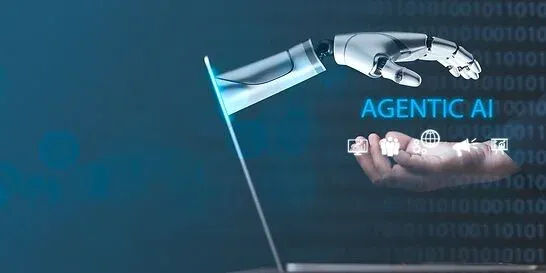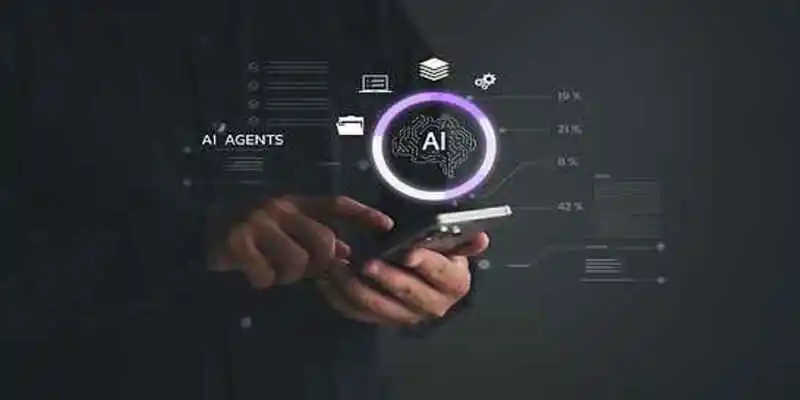Agentic AI Explained: Benefits, Challenges, and Use Cases
The thrilling future is here. Agentic AI represents a fundamental shift from AI as a passive tool to an active, collaborative partner. Explore how these extraordinary AI agents can automate complex workflows, transform customer experiences, and drive unprecedented efficiency across every sector.

Imagine an Artificial Intelligence that not only answers your questions but also acts on them. It doesn't just tell you the best time to climb Mount Everest—it books your flights, reserves your hotel, and manages your itinerary based on your schedule and preferences. This is Agentic AI.
We are moving beyond AI as a passive tool and entering the age of AI as an active, collaborative partner. These systems have agency—the capacity to perceive their environment, reason through problems, make decisions, and act purposefully with minimal supervision.
In this guide, you will learn how Agentic AI is shifting the way we interact with technology:
- Its various types and unique roles.
- How it is different from Artificial General Intelligence and Generative AI.
- The practical applications and benefits of Agentic AI across different industries.
- The challenges and considerations in implementing it effectively.
- Real-world examples illustrating the potential of this technology.
With these key topics in mind, let’s start by defining Agentic AI and AI agents.
What is Agentic AI and AI Agents?
Agentic AI gives artificial intelligence autonomy. It’s not just about thinking; it’s about doing. Let's start with a simple idea. Most AI we use today is like a smart assistant. You ask a question, it gives an answer. You request an image, it creates one. It's reactive.
Agentic AI is different. Think of it as a self-driving car for tasks. Instead of just answering, it takes the wheel. It makes decisions and completes multi-step jobs on its own to reach a goal you set.
An AI Agent is the "worker" that makes this happen. It's a software program powered by AI that can:
- Perceive its environment (like reading emails or checking data).
- Reason and make decisions (using a large language model as its "brain").
- Act by using tools (like sending an email, updating a spreadsheet, or placing an order).
- Learn from feedback to do better next time.
A Simple Example
- Generative AI: You ask a chatbot, "What's the weather tomorrow?" It tells you, "It will be sunny and 75°F."
- Agentic AI: You tell your AI agent, "Book me an outdoor picnic if the weather is nice tomorrow." The agent then checks the weather forecast, sees it will be sunny, and automatically reserves a spot at a park, all without you lifting a finger.
Agentic AI Market Forecast (2025-2029)
The table below consolidates the market forecasts from trusted sources to show the growing potential of agentic AI. In this context, a market forecast is an analysis that predicts how much the market for Agentic AI will grow over the next several years.
| Source | Market Data |
|---|---|
| MarketsandMarkets | The market is projected to expand from $7.06 billion in 2025 to $93.20 billion by 2032, achieving a remarkable compound annual growth rate (CAGR) of 44.6%. |
| World Economic Forum | The AI agent market, valued at $5.1 billion in 2024, is estimated to hit $47.1 billion by 2030. |
| Forbes Tech Concil | The sector is anticipated to grow at a 35% CAGR, reaching a projected market size of $126.9 billion by 2029. |
| PwC | Generative AI is expected to have a massive economic impact, potentially adding between $2.6 trillion and $4.4 trillion to the global economy each year by 2030. The future of this technology is "agentic," with AI agents collaborating to automate complex tasks. |
| GlobeNewswire | Valued at approximately $6.23 billion in 2024, the market is expected to soar to $107.28 billion by 2032, growing at a robust CAGR of 42.85% from 2025. |
| Capgemini | The market is projected to jump from $5.1 billion in 2024 to $52.6 billion by 2030, driven by the clear value Agentic AI delivers across various sectors. |
You will notice some variation in the figures from different sources. It is normal in market forecasting and can be due to a few factors:
- Different Scopes: Reports may define the "Agentic AI market" slightly differently, potentially including or excluding certain software or services.
- Base Years: Some projections start from 2024, while others use 2025 as a baseline, leading to different absolute values.
- Methodology: Each research firm uses its own models and assumptions to predict growth.
After reviewing the market outlook, let’s explore the main types of Agentic AI systems.
What are the Types of Agentic AI Systems?
Think of Agentic AI systems like a team of workers. Each worker has a specific role and way of operating. Some work alone, while others collaborate in groups.
Here are the main types of AI agents:
1. Single-Agent Systems
This is a solo worker. It's one AI agent that can handle a complex, multi-step task from start to finish on its own.
Example: A personal AI assistant that manages your entire calendar. It reads emails for meeting requests, checks your schedule, sends out invites, and even reschedules conflicts without any other AI's help.
2. Multi-Agent Systems
This is a team of specialists. Multiple AI agents work together, each with a specific expertise, to solve a larger, more complex problem.
Example: A software development team. One agent writes the code, another checks it for errors, a third writes the documentation, and a manager agent coordinates their work. They talk to each other to complete the project.
3. Hierarchical Agent Systems
This is a corporate-style structure. There's a "manager" agent at the top that breaks down a big goal and delegates sub-tasks to "worker" agents below it.
Example: An agent managing a business report. The manager agent receives the goal ("Create Q3 Sales Report"). It then commands a researcher agent to gather data, an analyst agent to find trends, and a writer agent to draft the document.
4. Autonomous Agent Systems
This is the most independent type. These agents are given a high-level goal and then operate for long periods with little to no human input. They learn and adapt along the way.
Example: An AI managing a stock portfolio. You tell it your goal ("Grow my investment by 10% annually"). It then continuously monitors the markets, buys and sells stocks, and adjusts its strategy based on performance, all on its own.
Agentic AI Vs Artificial General Intelligence
While both terms describe advanced AI, they represent fundamentally different concepts: one is a practical tool of the present, and the other is a theoretical goal for the future.
| Aspect | Agentic AI | AGI |
|---|---|---|
| Core Concept | "Specialist": Excels at autonomously executing specific, defined tasks. | “Generalist": Hypothetical AI with human-like cognitive abilities across any domain. |
| Scope | Narrow and task-oriented. Operates within predefined boundaries and goals. | Broad and unlimited. Can adapt to new problems it wasn't specifically trained for. |
| Current Status | Available today and being integrated into business software and workflows. | Does not exist yet; remains a long-term goal and theoretical concept in AI research |
| Example | An AI that autonomously manages a company's entire customer onboarding process from start to finish. | A hypothetical "AI CEO" that could run an entire business, handling everything from strategy to creative tasks. |
Agentic AI Vs Generative AI
This is a more common and practical distinction. Think of it as the difference between a "Doer" and a "Creator."
| Aspect | Agentic AI (the Doer) | Generative AI (the Creator) |
|---|---|---|
| Core Function | Takes action and executes multi-step tasks to achieve a goal. | Creates new content (text, images, code) in response to a prompt. |
| Autonomy | Proactive: Can operate for long periods with minimal human oversight. | Reactive: Requires a human prompt for every action and does not act on its own. |
| Workflow | Manages complex, multi-step processes from start to finish. | Best for single, discrete tasks (e.g., one question, one image). |
| Key Question | "What actions must I take to accomplish this goal?" | "What content should I create based on this prompt?" |
It's important to know that these two AIs are not rivals; they are powerful teammates. Agentic AI often uses Generative AI as a component to complete its goals.
A Simple Example: Sending a Follow-up Email
- Using Only Generative AI: You ask a chatbot to "Write a polite follow-up email to Maria." It generates the text. You then have to manually copy the text, open your email, paste it, and hit send.
- Using Agentic AI: You set a rule: "For any lead marked 'follow-up,' wait 2 days and send an email." The Agentic AI then autonomously retrieves the lead's details, uses a Generative AI tool to draft the email, and then utilizes an API to send it directly from your inbox, all without requiring your intervention.
How Does Agentic AI Work? The Core Principle Behind
Imagine giving a personal assistant a big goal, like "Plan my vacation to Italy." You wouldn't expect them to just snap their fingers and make it happen. They'd need to go through a process. Agentic AI works in a very similar way, using a continuous thinking-and-acting loop to get things done.
Here’s a simple breakdown of that process:
1. Perceive: The AI agent starts by gathering information. It scans its environment, which could be your email inbox, a company database, or live traffic data. It's like the assistant opening your calendar and reading your flight preference emails to understand the context.
2. Reason: Next, it uses its "brain"—typically a powerful large language model—to think. It analyzes the information it collected, figures out what you really want, and plans. For the vacation, this means deciding on destinations, creating a budget, and outlining a day-by-day itinerary.
3. Act: It is the crucial step that separates it from other AIs. It doesn't just suggest a plan; it executes it. The agent uses digital tools to search for flights, book the best hotels, and reserve tickets for tours, all on its own.
But it doesn't stop there. The agent operates in a loop. After it acts, it perceives the results again—"Was the flight booked successfully?"— reasons about what to do next, and takes further action. This "Reason-Act" loop continues until your entire vacation is fully planned and booked.
To do this effectively, the agent needs two key things:
- Memory: It remembers your preferences, past decisions, and what it has already done, so it doesn't ask you the same question twice.
- Tools: It can use software and apps (like booking sites or your calendar) as tools to interact with the digital world.
The Role of Agentic Architecture
The workflow described above is often managed by an agentic architecture. It provides the structure for one or more AI agents to operate. This is frequently implemented using the ReAct (Reason+Act) pattern, a design loop that allows the AI to continuously reason and act until a task is complete.
-
Single-Agent Systems: One AI agent handles a task from start to finish. This is simpler and more predictable, ideal for well-defined problems like a customer service chatbot handling a straightforward query.
-
Multi-Agent Systems: Multiple specialized AI agents collaborate on a complex problem. This is more robust and scalable, perfect for intricate workflows. For example, one agent could handle logistics while another manages customer communication. Multi-agent systems can be organized:
-
Vertically, with a "manager" agent overseeing "worker" agents in a hierarchy.
-
Horizontally, where agents work as equal peers, collaborating directly.
With the foundation set, let's examine its benefits.
What are the Benefits of Agentic AI?
Agentic AI is more than just a smart tool—it's a transformative force for business. It acts as a digital workforce that operates 24/7 while continuously improving your operations. Early adopters are already seeing transformative results across industries from customer service to software development.
Here’s how it delivers real-world value:
1. Hyper-Automation
Move beyond simple tasks. Agentic AI autonomously completes entire multi-step workflows without constant oversight.
2. Intelligent Decision-Making
It doesn't just follow rules—it analyzes real-time data to make proactive decisions. It can spot opportunities to prevent problems before they impact your business.
3. Massive Efficiency Gains
By automating complex operations and reducing manual errors, Agentic AI dramatically cuts costs. It scales your capabilities far beyond traditional limits.
4. Superior Customer Experiences
Agentic AI creates exceptional satisfaction and loyalty. It delivers instant, personalized service that adapts to each customer's unique needs and history.
5. Built-in Business Resilience
Keep operations running smoothly even during disruptions. Agentic AI continuously adapts to changing conditions, making your business more robust and agile.
6. Empowered Human Teams
Free your employees from repetitive work so they can focus on strategic thinking, creativity, and high-value activities that drive real growth.
What are the Challenges of Agentic AI?
While Agentic AI holds immense potential, most organizations face significant practical challenges in implementing it successfully. These hurdles are less about the technology itself and more about organizational readiness, technical infrastructure, and managing risks.
- Technical & Operational: Integration with legacy systems; data quality and accessibility; model reliability; lack of production-ready architecture.
- Organizational and Human: Unclear business value; lack of technical expertise; employee resistance and change management.
- Governance and Security: Evolving regulatory compliance; new security vulnerabilities; lack of governance frameworks; ethical concerns like bias.
Use Cases of Agentic AI: Real World Applications
Agentic AI moves from theoretical potential to real-world application. It transforms how work gets done across entire industries by autonomously executing complex, multi-step tasks. Below are some of the most impactful use cases where it is already making a difference.
1. Enterprise Operations
In the corporate world, Agentic AI is acting as a digital workforce. It takes over entire workflows and boosts efficiency across departments.
- IT Support: Agentic AI systems can proactively identify and resolve IT issues. They go beyond following static scripts by dynamically adapting to new problems, integrating data from various management systems, and autonomously handling tasks from password resets to VPN troubleshooting. For instance, Power Design deployed an AI assistant called "HelpBot" that automates over 1,000 hours of complex tasks, freeing IT staff for more strategic work.
- Human Resources: HR teams use Agentic AI to automate the entire recruitment lifecycle. It starts from screening resumes and scheduling interviews to providing personalized onboarding support. These systems can also answer employee questions about policies and benefits, as demonstrated by Palo Alto Networks' AI Assistant that offers personalized support to a global, hybrid workforce.
- Finance: In the financial sector, Agentic AI automates expense reporting, compliance checks, and fraud detection. It can analyze vast amounts of data to generate audit-ready reports and even provide personalized financial management. Bud Financial, for example, uses agentic AI to help customers autonomously manage their money, such as by transferring funds to prevent overdraft fees.
2. Industrial & Retail Transformation
For sectors dealing with physical goods and customer interactions, Agentic AI drives optimization and personalization.
- Manufacturing & Logistics: Companies are using Agentic AI to reimagine research and development and optimize logistics. One automotive supplier uses a squad of AI agents to automate the generation of test case descriptions for new requirements, cutting the time for this task by 50% for junior engineers. In logistics, autonomous routing and scheduling have led to a more than 20% drop in inventory and logistics costs.
- Retail & Sales: Retailers like Leroy Merlin and Carrefour are deploying Agentic AI to create hyper-personalized customer experiences and optimize logistics. Carrefour's "ClubAI" acts as a personalized loyalty program assistant, offering tailored recipes and content. In sales, one truck manufacturer implemented a multi-agent system that autonomously researches and qualifies new sales leads, leading to a 40% increase in order intake within months.
3. Innovation & Specialized Fields
Agentic AI is also a powerful tool for driving innovation and handling specialized, high-stakes tasks.
- Software Engineering & Development: AI agents are acting as autonomous developers. They can build entire applications, generate and refactor code, modernize legacy systems, and manage CI/CD pipelines based on natural language commands. Tools like Cursor and Replit allow developers to instruct agents to build features or even complete games, dramatically accelerating development cycles.
- Cybersecurity: In security operations, Agentic AI shifts the role from assistant to autonomous defender. These systems can continuously monitor network traffic, detect and investigate threats, and even execute automated responses like isolating compromised endpoints. The future of cybersecurity will involve "‘good AI’ and ‘bad AI’ fighting it out," with humans in a critical oversight role.
- Autonomous Vehicles: These are a premier example of Agentic AI in action, and several major companies are leading this charge. These self-driving systems perfectly embody the definition of Agentic AI, as they autonomously perceive their environment, reason, plan, and act to achieve the goal of safe navigation. The table below highlights how leading companies are implementing Agentic AI in autonomous vehicles.
| Company Name | Key Application |
|---|---|
| Waymo | Fully autonomous ride-hailing service. |
| Cruise | Development and testing of self-driving taxis. |
| Argo AI | R&D for self-driving system software and hardware. |
| Tesla | Evolving semi-autonomous driving system (Autopilot). |
The Future of Agentic AI
Based on industry insights, the future of Agentic AI points toward deeper integration into business and daily life, moving from general-purpose tools to specialized systems that deliver measurable value. The technology is expected to become more collaborative, personalized, and physically embodied.
The table below summarizes the key trends shaping the future of Agentic AI:
| Trend | Description | Impact |
|---|---|---|
| Vertical, Domain-Specific Agents | Shift from general-purpose to industry-specific agents (e.g., for legal, healthcare, finance) that possess deep, proprietary knowledge. | Higher, more measurable ROI by automating complex, specialized workflows and providing expert-level support. |
| Multi-Agent Collaboration | Move from single agents to teams of specialized AI agents that can discover each other, communicate, and collaborate to solve complex problems. | Enables automation of entire business processes, not just single tasks, leading to greater efficiency and more sophisticated outcomes. |
| Ambient & Proactive Assistance | Agents will evolve from reactive tools to proactive partners by passively learning from user context (e.g., documents, calendars, browsing). | Highly personalized and anticipatory assistance, with agents acting on your behalf before you even ask. |
| Integration with the Physical World | Bridging the digital and physical realms through robotics and Internet of Things (IoT) devices, allowing AI to act in real-world environments. | Opens new applications in smart cities, manufacturing, and healthcare, such as autonomous robotic systems for medical imaging. |
A significant part of this future will be governed by orchestration frameworks and open standards that allow these diverse agents to work together safely and efficiently. Industry efforts, such as the push for open standards like the Model Context Protocol (MCP) and Agent-to-Agent (A2A) communication, are crucial for creating a connected ecosystem rather than a collection of isolated, "walled garden" agents. Furthermore, to ensure trust and safety at scale, human-in-the-loop oversight will remain essential, particularly for high-stakes decisions, creating a collaborative partnership between humans and AI.
Frequently Asked Question
Q1: What is the difference between Agentic AI and AI Agents?
Think of it this way: Agentic AI is the overall capability or technology that enables autonomous action, while an AI Agent is an individual instance that uses this capability.
Q2: What is the main difference between Agentic AI and Generative AI?
Generative AI creates content (text, images, code) when you prompt it. Agentic AI acts. It uses generative AI as one of its tools to complete tasks autonomously, like a personal assistant who not only writes emails but actually sends them.
Q3: Can Agentic AI work without human supervision?
While designed for autonomy, most business systems keep "humans in the loop" for oversight. The AI handles routine tasks and escalates complex decisions to people for a collaborative partnership rather than full replacement.
Q4: What industries are adopting Agentic AI fastest?
Customer service, software development, and IT operations are leading adoption. Companies are using AI agents for 24/7 customer support, automated code generation, and resolving IT tickets without human intervention.
Q5: Is Agentic AI the same as Artificial General Intelligence (AGI)?
No. Agentic AI are specialized systems that excel at specific tasks. AGI refers to hypothetical future AI with human-like general reasoning abilities. Agentic AI is a practical tool available today, while AGI remains theoretical.
Q6: How do AI agents "learn" and improve over time?
AI Agents work through reinforcement learning and feedback loops. When an agent completes a task, it evaluates the outcome and adjusts its future strategies. Some systems also learn from new data and user corrections.
Q7: What's the biggest challenge with Agentic AI implementation?
Integration with existing systems and ensuring reliability is one of the biggest challenges with its implementation. Connecting AI agents to legacy software requires significant technical work, and companies must build safeguards to prevent errors in autonomous operations.
Q8: Can small businesses benefit from Agentic AI?
Absolutely. Cloud-based AI services are making agentic capabilities accessible to businesses of all sizes. Small businesses can use them for customer service, marketing automation, and administrative tasks without large upfront investment.
Q9: Are AI agents secure for handling sensitive business data?
Security is a priority. Reputable providers implement enterprise-grade encryption, access controls, and compliance frameworks. However, companies should carefully vet AI vendors and establish clear data governance policies.
Q10: When will we see widespread adoption of Agentic AI?
Significant adoption is already happening. Gartner predicts that 40% of enterprise applications will be integrated with task-specific AI agents, up from less than 5% in 2025.
Conclusion
Agentic AI represents a fundamental shift from AI as a passive tool to an active, collaborative partner. We've explored how these thinking, acting systems can automate complex workflows, transform customer experiences, and drive unprecedented efficiency across every sector. While challenges around implementation and governance remain, the potential is undeniable: a future where humans and AI agents work together to achieve what neither could do alone.
As we stand at the beginning of this agentic revolution, one crucial question emerges: How will we redesign our organizations and workflows to harness the full potential of these autonomous partners?
The conversation is just beginning.


